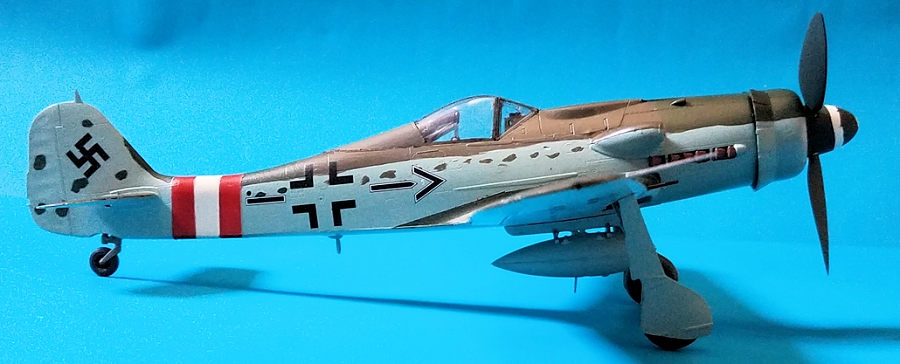
Hobby Boss 1/48 FW-190D-9
| KIT #: | 81716 |
| PRICE: | $20.00 |
| DECALS: | Two options |
| REVIEWER: | Francisco Santoro |
| NOTES: | Perfect fit all around |

| HISTORY |
From Eduard´s instructions: "The Fw 190A was falling short of its
adversaries, especially at higher altitudes. The design development led
first through the Fw 190B, powered by a BMW 801 with turbo supercharger,
followed by the Fw 190C, powered by an in-line DB 603, but was finalised on
the Fw 190D. Conversion to the D version, and namely the Fw 190D-9, involved
the installation of a new liquid cooled 12 cylinder Jumo 213A, rated at
1726hp. The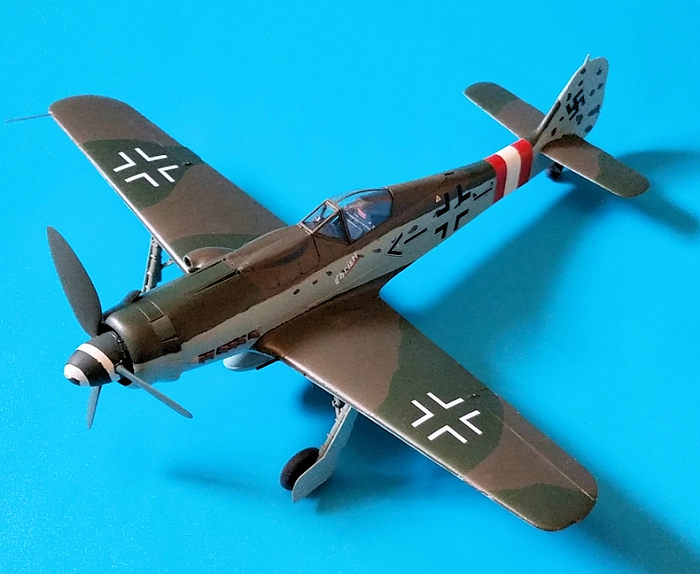 front of the aircraft was therefore lengthened from the Fw 190A, which was
fitted with a BMW 801 radial engine. In order to maintain the centre of
gravity, there was a 50cm extension to the rear of the plane, and a
relocation of some internal components. The overall length, compared to the
A-9, was increased by 1,52m. The aircraft gained a new, more elegant shape,
and was dubbed "Langnasen Dora (Long nosed Dora)."
front of the aircraft was therefore lengthened from the Fw 190A, which was
fitted with a BMW 801 radial engine. In order to maintain the centre of
gravity, there was a 50cm extension to the rear of the plane, and a
relocation of some internal components. The overall length, compared to the
A-9, was increased by 1,52m. The aircraft gained a new, more elegant shape,
and was dubbed "Langnasen Dora (Long nosed Dora)."
About Gerhard Barkhorn: Gerhard Barkhorn was born on 20th May, 1919, in Königsberg, East Prussia. He joined the Luftwaffe in 1937, began training in 1938, and was posted to 3/JG 2 after he finished it. He was assigned to 6/JG 52 in the Channel Front on August 1 1940. During the Battle of Britain Barkhorn didn´t shoot down any aircraft. His first victory would come in the East, when he shot down a Russian aircraft in July 2nd of 1941. His score steadily rose, and he achieved his 10th kill on November 30th 1941. Barkhorn ascended to Staffelkapitän of 4/JG 52 on May 21st 1941. On July 20th of 1941, he shot down his 56th aircraft, and was awarded the Knight's Cross on August 23rd 1942 after his 64th kill. Barkhorn's 100 kill would come on 19th December 1942. He was awarded the Oak Leaves to his Knight's Cross on January 11th 1943 because of his 105th victory.
Barkhorn became Gruppenkomandeur of II/JG 52 on 1st September of 1943, a unit the he would lead until 15th January 1945. He achieved his 150th kill on August 8th, and his 200th one on November 30 of 1943. Barkhorn got his 250th shot down on February 12th of 1944 (the second pilot to reach it). He received the Swords to his Knight's Cross with Oak Leaves for his 251st kill on March 2nd 1944.
Barkhorn would be put into a hospital bed after being shot down by a Russian P-39 on May 31st 1944, and would spend 4 months recovering from the injuries on his right arm and leg. Barkhorn went back to the frontline in October of 1944, claiming his 275th kill on November of that year, and shooting down his 301st aircraft on January 5th 1945.
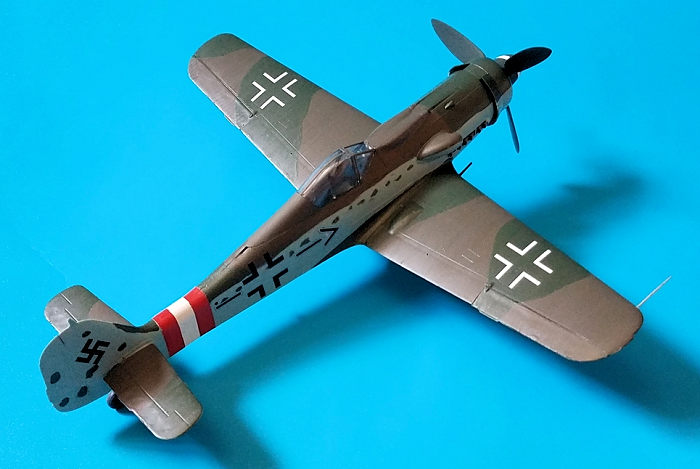 Barkhorn
was transferred to JG 6 for Defense of the Reich duties on Janury 16th of
1945, and would lead the unit until 10th April 1945.
Barkhorn
was transferred to JG 6 for Defense of the Reich duties on Janury 16th of
1945, and would lead the unit until 10th April 1945.
Gerhard Barkhorn joined JV 44 (operating the Me 262) after spending more time in hospital due to his previous injuries. On 21st April 1945 and flying the Me 262, Barkhorn had to break his attack on a B-17 because of an engine failure, while being chased by a P-51. He crashlanded his aircraft, and the canopy (which he had opened to facilitate his escape), slammed shut on his neck, sending him back to the hospital again, and where he´d see WW2's end. Barkhorn was later captured by the Allies, but was released in September of 1945. He was also one of the few Luftwaffe Experten to not be sent to the Russian gulags.
In 1956, Gerhard Barkhorn joined the Bundesluftwaffe and directed JaBoG "Boelcke," and rose to the rank of Generalleutnant, retiring in 1976.
Gerhard Barkhorn and his wife Christl had a car accident on January 6th 1983. She died in the crash, but Barkhorn would live two more days before passing away on January 8th 1983.
| THE KIT |
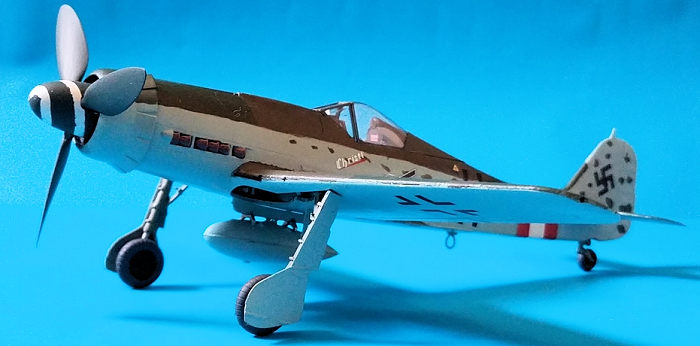 Seven
sprues of light grey and clear plastic and a small etched fret come all
separately bagged inside a top opening box. The parts are cleanly molded with no
traces of flash and with neatly done recessed panel lines. Clear parts are
bagged separately and are protected by an extra layer of foam. The etch fret has
the rear cockpit deck and the trim wheel.
Seven
sprues of light grey and clear plastic and a small etched fret come all
separately bagged inside a top opening box. The parts are cleanly molded with no
traces of flash and with neatly done recessed panel lines. Clear parts are
bagged separately and are protected by an extra layer of foam. The etch fret has
the rear cockpit deck and the trim wheel.
Instructions are of the booklet type, and have 9 steps in black and white that clearly show where each part goes.
Decals are nicely printed and are glossy, so you shouldn´t have any trouble with them. A warning though, I bought two D-9s, and one had sections of the decals sliced (crosses and RVD band), the other kit was fine, but I suggest you check every HB decal sheet before leaving the store. The sheet was factory sealed.
| CONSTRUCTION |
I began by painting painting all the cockpit parts with Revell 78 (RLM
66), the engine in flat black, and the engine firewall with Revell 45 (RLM 02).
The fuselage halves were painted in RLM 66 and the tailwheel assembly was
painted in RLM 02. Before I forgot, I glued the exhaust stacks into both
fuselage halves. When the paint was dry, I glued everything together and let it
to set for some minutes. I glued the cockpit, instrument panel, engine and
tailwheel into place, and temporarily closed both fuselage halves so I could al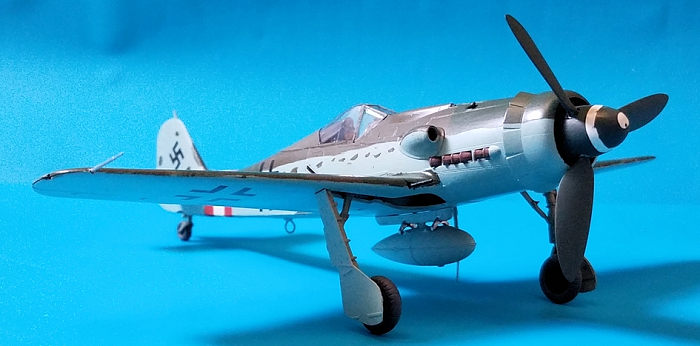 ign
them properly. Once those four subassemblies were dry, I glued both fuselage
halves and used some tape to hold everything in place. With the halves dry, I
glued the engine cowling (which also has the machineguns) and passed on to the
wings.
ign
them properly. Once those four subassemblies were dry, I glued both fuselage
halves and used some tape to hold everything in place. With the halves dry, I
glued the engine cowling (which also has the machineguns) and passed on to the
wings.
The wings are made of three main pieces: top wings, bottom wing and wheel well. I opened the middle holes for the fuel tank rack, and left the others as is, because I wasn´t using the bombs. The wheel well was painted in RLM 02 together with other details. I then glued the wells to the bottom wing half, and added the wing guns. I then glued the top halves and set this assembly aside until it dried.
Trying to fit the wings and the fuselage took a bit more effort than with my other 190D-9 from Hobby Boss. This time the front part of the wings wouldn´t sit properly with the front of the fuselage, so I used tape and pressure to melt the union and fix it into place. I glued the horizontal stabilisers next and set off to the paint booth.
| COLORS & MARKINGS |
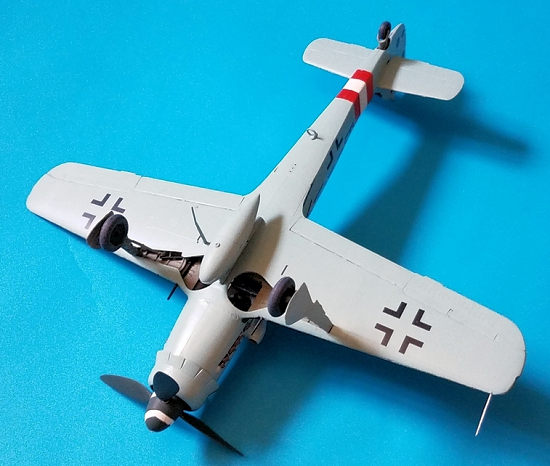 I
wanted to build Gerhard Barkhorn's machine, so I began by first painting the RVD
band of JG 6. I masked an area of 9mm on the rear of the fuselage, painted it
white and then masked the white to paint the red. With that done, I masked the
band and painted the camouflage colours with Revell Aqua 46 (RLM 81) and Revell
Aqua 65 (RLM 82). The undersides were painted with Revell Aqua 49 Light Blue.
I
wanted to build Gerhard Barkhorn's machine, so I began by first painting the RVD
band of JG 6. I masked an area of 9mm on the rear of the fuselage, painted it
white and then masked the white to paint the red. With that done, I masked the
band and painted the camouflage colours with Revell Aqua 46 (RLM 81) and Revell
Aqua 65 (RLM 82). The undersides were painted with Revell Aqua 49 Light Blue.
I left everything to dry properly, and brushed two coats of Revell Aqua Gloss varnish to prepare the surface for the decals. I used Sky Models decal sheet Sky 48057 "Focke Wulf 190D/TA 152," which comes with multiple decal options, including the ones for Barkhorn's aircraft. Decals performed flawlesly, and I had a completely decalled model in under one hour. After letting the decals dry for a day, I brushed a coat of Revell's Matt varnish.
I glued the landing gear (which has very positive locating pins), wheels and fuel tank, and called the model done.
| CONCLUSIONS |
This is by far the easiest and most pleasant kit I've ever built, it's cheap and everything fits! If you have multiple aftermarket decal sheets, you can buy several of Hobby Boss's D-9 and make a Gruppe in little time
Francisco Santoro
30 April 2020
Copyright ModelingMadness.com
If you would like your product reviewed fairly and fairly quickly, please contact the editor or see other details in the Note to Contributors.
Back to the Main Page Back to the Review Index Page Back to the Previews Index Page